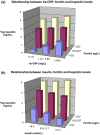Association of hepcidin-25 with survival after kidney transplantation
- PMID: 27696386
- PMCID: PMC5132077
- DOI: 10.1111/eci.12682
Association of hepcidin-25 with survival after kidney transplantation
Abstract
Background: Hepcidin is considered the master regulator of iron homoeostasis. Novel hepcidin antagonists have recently been introduced as potential treatment for iron-restricted anaemia. Meanwhile, serum hepcidin has been shown to be positively associated with cardiovascular disease and inversely with acute kidney injury. These properties may lead to contrasting effects, especially in renal transplant recipients (RTR), which are prone to cardiovascular diseases and graft failure. To date, the role of serum hepcidin in RTR is unknown. We, therefore, prospectively determined the association of serum hepcidin with risk of graft failure, cardiovascular mortality and all-cause mortality in RTR.
Materials and methods: Serum hepcidin was assessed in an extensively phenotyped RTR cohort by dual-monoclonal sandwich ELISA specific immunoassay. Statistical analyses were performed using univariate linear regression followed by stepwise backward linear regression. Cox proportional hazard regression models were performed to determine prospective associations.
Results: We included 561 RTR (age 51 ± 12 years). Mean haemoglobin (Hb) was 8·6 ± 1·0 mM. Median [IQR] serum hepcidin was 7·2 [3·2-13·4] ng/mL. Mean estimated glomerular filtration rate was 47 ± 16 mL/min/1·73 m2 . In univariate Cox regression analyses, serum hepcidin was not associated with risk of graft failure, cardiovascular mortality or all-cause mortality. Notably, after adjustment for high sensitivity C-reactive protein and ferritin, serum hepcidin became negatively associated with all-cause mortality (hazard ratio 0·89; 95% confidence interval 0·80-0·99, P = 0·03).
Conclusions: In this study, we did not find an association between serum hepcidin and outcomes, that is graft failure, cardiovascular mortality or all-cause mortality. Based on our results, it is questionable whether serum hepcidin may be used to predict a beneficial effect of hepcidin antagonists.
Keywords: Determinants; graft failure; hepcidin; mortality; renal transplantation.
© 2016 The Authors. European Journal of Clinical Investigation published by John Wiley & Sons Ltd on behalf of Stichting European Society for Clinical Investigation Journal Foundation.
Figures


References
-
- Imoagene‐Oyedeji AE, Rosas SE, Doyle AM, Goral S, Bloom RD. Posttransplantation anemia at 12 months in kidney recipients treated with mycophenolate mofetil: risk factors and implications for mortality. J Am Soc Nephrol 2006;17:3240. - PubMed
-
- Weiss G. Iron metabolism in the anemia of chronic disease. Biochim Biophys Acta 2009;1790:682. - PubMed
-
- Young B, Zaritsky J. Hepcidin for clinicians. Clin J Am Soc Nephrol 2009;4:1384. - PubMed
MeSH terms
Substances
LinkOut - more resources
Full Text Sources
Other Literature Sources
Medical
Research Materials

